二十二、Hadoop学记笔记————Kafka 基础实战 :消费者和生产者实例
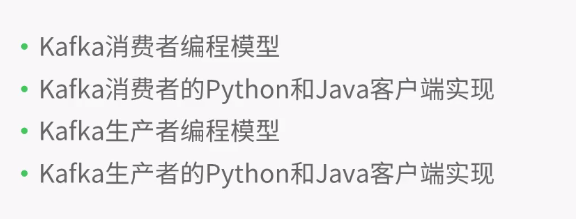
kafka的客户端也支持其他语言,这里主要介绍python和java的实现,这两门语言比较主流和热门
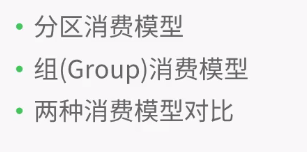
图中有四个分区,每个图形对应一个consumer,任意一对一即可
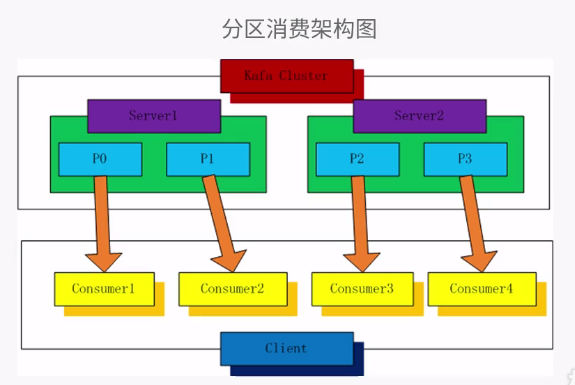
获取topic的分区数,每个分区创建一个进程消费分区中的数据。
每个进程的实例中,先要创建连接kafka的实例,然后指定连接到哪个topic(主图),哪个分区
之后要设置kafka的偏移量,kafka中每条消息都有偏移量,如果消费者突然宕机了,则可以从上个偏移量继续消费
提交偏移量的工作客户端都会默认操作,因此提交偏移量可选
后续会根据伪代码描述编写程序
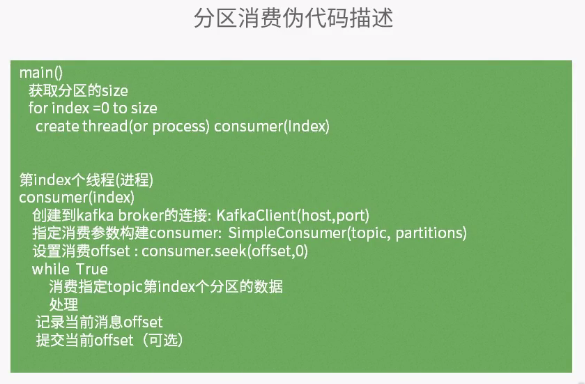
GroupA和GourpB都能拿到当前topic的全部数据,组消费可以复制消费,即kafka会复制消息分别发送给组A和组B
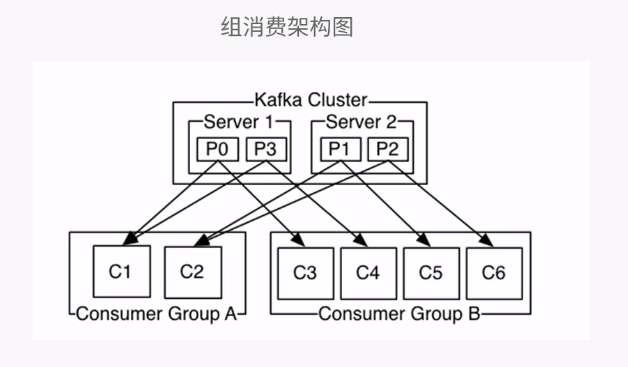
流数N指代每个Gourp中有都少个consumer,上图中A有2个流,B有4个流
每个consumer实力也需要创建连接kafka的实例,设置连接到哪个topic和分区
也可以设置偏移量,与分区消费一样
按组消费可以选择从头消费还是从最新消费
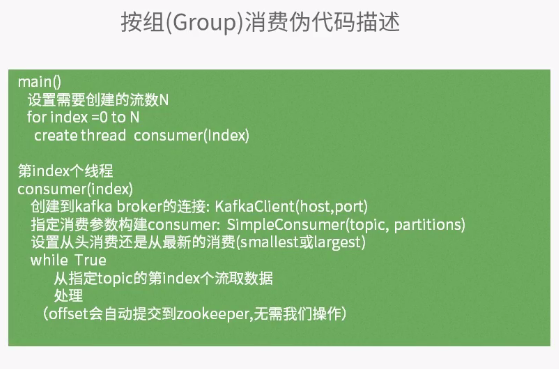
PT代表topic T下的所有分区,CG代表Group中有多少个consumer实例
排序分区parition,排序consumer
对于前面的例子GourpA,就是PT=4,CG=2,所以N等于2
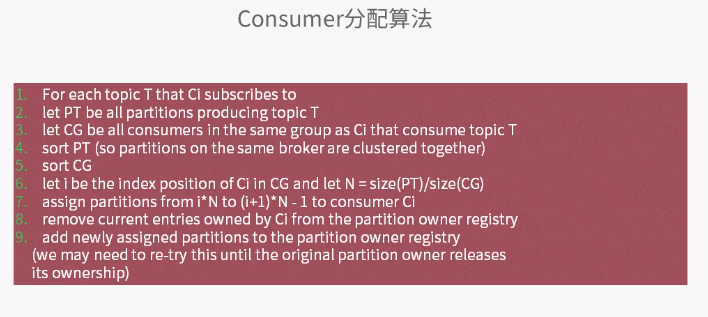
分区模式中,所有生产者也默认至少发送一次消息,但是可以自定义发送一次接受一次,或者只发送一次不管是否接收
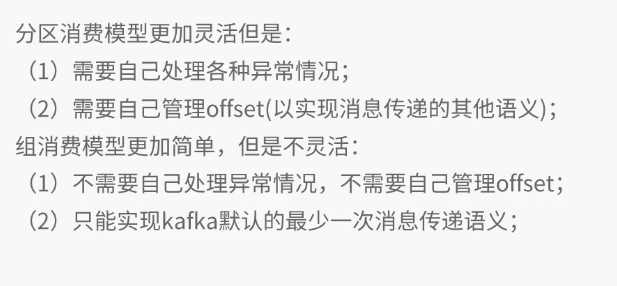
kafka版本与服务器一致即可

pom文件如下
<project xmlns="http://maven.apache.org/POM/4.0.0" xmlns:xsi="http://www.w3.org/2001/XMLSchema-instance"
xsi:schemaLocation="http://maven.apache.org/POM/4.0.0 http://maven.apache.org/xsd/maven-4.0.0.xsd">
<modelVersion>4.0.0</modelVersion> <groupId>com.jike.kafkatest</groupId>
<artifactId>JikeKafka</artifactId>
<version>1.0</version>
<packaging>jar</packaging> <name>JikeKafka</name>
<url>http://maven.apache.org</url> <properties>
<project.build.sourceEncoding>UTF-8</project.build.sourceEncoding>
</properties> <dependencies>
<dependency>
<groupId>junit</groupId>
<artifactId>junit</artifactId>
<version>3.8.1</version>
<scope>test</scope>
</dependency>
<dependency>
<groupId>org.apache.kafka</groupId>
<artifactId>kafka_2.9.2</artifactId>
<version>0.8.1.1</version>
<exclusions>
<exclusion>
<artifactId>jmxri</artifactId>
<groupId>com.sun.jmx</groupId>
</exclusion>
<exclusion>
<artifactId>jms</artifactId>
<groupId>javax.jms</groupId>
</exclusion>
<exclusion>
<artifactId>jmxtools</artifactId>
<groupId>com.sun.jdmk</groupId>
</exclusion>
</exclusions>
</dependency>
<dependency>
<groupId>org.apache.avro</groupId>
<artifactId>avro</artifactId>
<version>1.7.3</version>
</dependency>
<dependency>
<groupId>org.apache.avro</groupId>
<artifactId>avro-ipc</artifactId>
<version>1.7.3</version>
</dependency>
</dependencies>
<build>
<sourceDirectory>src/main/java</sourceDirectory>
<testSourceDirectory>src/test/java</testSourceDirectory>
<plugins>
<!--
Bind the maven-assembly-plugin to the package phase
this will create a jar file without the storm dependencies
suitable for deployment to a cluster.
-->
<plugin>
<artifactId>maven-assembly-plugin</artifactId>
<configuration>
<descriptorRefs>
<descriptorRef>jar-with-dependencies</descriptorRef>
</descriptorRefs>
<archive>
<manifest>
<mainClass></mainClass>
</manifest>
</archive>
</configuration>
<executions>
<execution>
<id>make-assembly</id>
<phase>package</phase>
<goals>
<goal>single</goal>
</goals>
</execution>
</executions>
</plugin>
</plugins>
</build>
</project>
分组模式下Java代码如下:
package kafka.consumer.group; import kafka.consumer.ConsumerIterator;
import kafka.consumer.KafkaStream; public class ConsumerTest implements Runnable {
private KafkaStream m_stream;
private int m_threadNumber; public ConsumerTest(KafkaStream a_stream, int a_threadNumber) {
m_threadNumber = a_threadNumber;
m_stream = a_stream;
} public void run() {
ConsumerIterator<byte[], byte[]> it = m_stream.iterator();
while (it.hasNext()){
System.out.println("Thread " + m_threadNumber + ": " + new String(it.next().message())); }
System.out.println("Shutting down Thread: " + m_threadNumber);
}
}
package kafka.consumer.group; import kafka.consumer.ConsumerConfig;
import kafka.consumer.KafkaStream;
import kafka.javaapi.consumer.ConsumerConnector; import java.util.HashMap;
import java.util.List;
import java.util.Map;
import java.util.Properties;
import java.util.concurrent.ExecutorService;
import java.util.concurrent.Executors;
import java.util.concurrent.TimeUnit; public class GroupConsumerTest extends Thread {
private final ConsumerConnector consumer;
private final String topic;
private ExecutorService executor; public GroupConsumerTest(String a_zookeeper, String a_groupId, String a_topic){
consumer = kafka.consumer.Consumer.createJavaConsumerConnector(
createConsumerConfig(a_zookeeper, a_groupId));
this.topic = a_topic;
} public void shutdown() {
if (consumer != null) consumer.shutdown();
if (executor != null) executor.shutdown();
try {
if (!executor.awaitTermination(Long.MAX_VALUE, TimeUnit.MILLISECONDS)) {
System.out.println("Timed out waiting for consumer threads to shut down, exiting uncleanly");
}
} catch (InterruptedException e) {
System.out.println("Interrupted during shutdown, exiting uncleanly");
}
} public void run(int a_numThreads) {
Map<String, Integer> topicCountMap = new HashMap<String, Integer>();
topicCountMap.put(topic, new Integer(a_numThreads));
Map<String, List<KafkaStream<byte[], byte[]>>> consumerMap = consumer.createMessageStreams(topicCountMap);
List<KafkaStream<byte[], byte[]>> streams = consumerMap.get(topic); // now launch all the threads
//
executor = Executors.newFixedThreadPool(a_numThreads); // now create an object to consume the messages
//
int threadNumber = 0;
for (final KafkaStream stream : streams) {
executor.submit(new ConsumerTest(stream, threadNumber));
threadNumber++;
}
}
private static ConsumerConfig createConsumerConfig(String a_zookeeper, String a_groupId) {
Properties props = new Properties();
props.put("zookeeper.connect", a_zookeeper);
props.put("group.id", a_groupId);
props.put("zookeeper.session.timeout.ms", "40000");
props.put("zookeeper.sync.time.ms", "2000");
props.put("auto.commit.interval.ms", "1000"); return new ConsumerConfig(props);
} public static void main(String[] args) {
if(args.length < 1){
System.out.println("Please assign partition number.");
} String zooKeeper = "10.206.216.13:12181,10.206.212.14:12181,10.206.209.25:12181";
String groupId = "jikegrouptest";
String topic = "jiketest";
int threads = Integer.parseInt(args[0]); GroupConsumerTest example = new GroupConsumerTest(zooKeeper, groupId, topic);
example.run(threads); try {
Thread.sleep(Long.MAX_VALUE);
} catch (InterruptedException ie) { }
example.shutdown();
}
}
分区模式下Java代码如下:
package kafka.consumer.partition; import kafka.api.FetchRequest;
import kafka.api.FetchRequestBuilder;
import kafka.api.PartitionOffsetRequestInfo;
import kafka.common.ErrorMapping;
import kafka.common.TopicAndPartition;
import kafka.javaapi.*;
import kafka.javaapi.consumer.SimpleConsumer;
import kafka.message.MessageAndOffset; import java.nio.ByteBuffer;
import java.util.ArrayList;
import java.util.Collections;
import java.util.HashMap;
import java.util.List;
import java.util.Map; public class PartitionConsumerTest {
public static void main(String args[]) {
PartitionConsumerTest example = new PartitionConsumerTest();
long maxReads = Long.MAX_VALUE;
String topic = "jiketest";
if(args.length < 1){
System.out.println("Please assign partition number.");
} List<String> seeds = new ArrayList<String>();
String hosts="10.206.216.13,10.206.212.14,10.206.209.25";
String[] hostArr = hosts.split(",");
for(int index = 0;index < hostArr.length;index++){
seeds.add(hostArr[index].trim());
} int port = 19092; int partLen = Integer.parseInt(args[0]);
for(int index=0;index < partLen;index++){
try {
example.run(maxReads, topic, index/*partition*/, seeds, port);
} catch (Exception e) {
System.out.println("Oops:" + e);
e.printStackTrace();
}
}
} private List<String> m_replicaBrokers = new ArrayList<String>(); public PartitionConsumerTest() {
m_replicaBrokers = new ArrayList<String>();
} public void run(long a_maxReads, String a_topic, int a_partition, List<String> a_seedBrokers, int a_port) throws Exception {
// find the meta data about the topic and partition we are interested in
//
PartitionMetadata metadata = findLeader(a_seedBrokers, a_port, a_topic, a_partition);
if (metadata == null) {
System.out.println("Can't find metadata for Topic and Partition. Exiting");
return;
}
if (metadata.leader() == null) {
System.out.println("Can't find Leader for Topic and Partition. Exiting");
return;
}
String leadBroker = metadata.leader().host();
String clientName = "Client_" + a_topic + "_" + a_partition; SimpleConsumer consumer = new SimpleConsumer(leadBroker, a_port, 100000, 64 * 1024, clientName);
long readOffset = getLastOffset(consumer,a_topic, a_partition, kafka.api.OffsetRequest.EarliestTime(), clientName); int numErrors = 0;
while (a_maxReads > 0) {
if (consumer == null) {
consumer = new SimpleConsumer(leadBroker, a_port, 100000, 64 * 1024, clientName);
}
FetchRequest req = new FetchRequestBuilder()
.clientId(clientName)
.addFetch(a_topic, a_partition, readOffset, 100000) // Note: this fetchSize of 100000 might need to be increased if large batches are written to Kafka
.build();
FetchResponse fetchResponse = consumer.fetch(req); if (fetchResponse.hasError()) {
numErrors++;
// Something went wrong!
short code = fetchResponse.errorCode(a_topic, a_partition);
System.out.println("Error fetching data from the Broker:" + leadBroker + " Reason: " + code);
if (numErrors > 5) break;
if (code == ErrorMapping.OffsetOutOfRangeCode()) {
// We asked for an invalid offset. For simple case ask for the last element to reset
readOffset = getLastOffset(consumer,a_topic, a_partition, kafka.api.OffsetRequest.LatestTime(), clientName);
continue;
}
consumer.close();
consumer = null;
leadBroker = findNewLeader(leadBroker, a_topic, a_partition, a_port);
continue;
}
numErrors = 0; long numRead = 0;
for (MessageAndOffset messageAndOffset : fetchResponse.messageSet(a_topic, a_partition)) {
long currentOffset = messageAndOffset.offset();
if (currentOffset < readOffset) {
System.out.println("Found an old offset: " + currentOffset + " Expecting: " + readOffset);
continue;
}
readOffset = messageAndOffset.nextOffset();
ByteBuffer payload = messageAndOffset.message().payload(); byte[] bytes = new byte[payload.limit()];
payload.get(bytes);
System.out.println(String.valueOf(messageAndOffset.offset()) + ": " + new String(bytes, "UTF-8"));
numRead++;
a_maxReads--;
} if (numRead == 0) {
try {
Thread.sleep(1000);
} catch (InterruptedException ie) {
}
}
}
if (consumer != null) consumer.close();
} public static long getLastOffset(SimpleConsumer consumer, String topic, int partition,
long whichTime, String clientName) {
TopicAndPartition topicAndPartition = new TopicAndPartition(topic, partition);
Map<TopicAndPartition, PartitionOffsetRequestInfo> requestInfo = new HashMap<TopicAndPartition, PartitionOffsetRequestInfo>();
requestInfo.put(topicAndPartition, new PartitionOffsetRequestInfo(whichTime, 1));
kafka.javaapi.OffsetRequest request = new kafka.javaapi.OffsetRequest(
requestInfo, kafka.api.OffsetRequest.CurrentVersion(), clientName);
OffsetResponse response = consumer.getOffsetsBefore(request); if (response.hasError()) {
System.out.println("Error fetching data Offset Data the Broker. Reason: " + response.errorCode(topic, partition) );
return 0;
}
long[] offsets = response.offsets(topic, partition);
return offsets[0];
} private String findNewLeader(String a_oldLeader, String a_topic, int a_partition, int a_port) throws Exception {
for (int i = 0; i < 3; i++) {
boolean goToSleep = false;
PartitionMetadata metadata = findLeader(m_replicaBrokers, a_port, a_topic, a_partition);
if (metadata == null) {
goToSleep = true;
} else if (metadata.leader() == null) {
goToSleep = true;
} else if (a_oldLeader.equalsIgnoreCase(metadata.leader().host()) && i == 0) {
// first time through if the leader hasn't changed give ZooKeeper a second to recover
// second time, assume the broker did recover before failover, or it was a non-Broker issue
//
goToSleep = true;
} else {
return metadata.leader().host();
}
if (goToSleep) {
try {
Thread.sleep(1000);
} catch (InterruptedException ie) {
}
}
}
System.out.println("Unable to find new leader after Broker failure. Exiting");
throw new Exception("Unable to find new leader after Broker failure. Exiting");
} private PartitionMetadata findLeader(List<String> a_seedBrokers, int a_port, String a_topic, int a_partition) {
PartitionMetadata returnMetaData = null;
loop:
for (String seed : a_seedBrokers) {
SimpleConsumer consumer = null;
try {
consumer = new SimpleConsumer(seed, a_port, 100000, 64 * 1024, "leaderLookup");
List<String> topics = Collections.singletonList(a_topic);
TopicMetadataRequest req = new TopicMetadataRequest(topics);
kafka.javaapi.TopicMetadataResponse resp = consumer.send(req); List<TopicMetadata> metaData = resp.topicsMetadata();
for (TopicMetadata item : metaData) {
for (PartitionMetadata part : item.partitionsMetadata()) {
if (part.partitionId() == a_partition) {
returnMetaData = part;
break loop;
}
}
}
} catch (Exception e) {
System.out.println("Error communicating with Broker [" + seed + "] to find Leader for [" + a_topic
+ ", " + a_partition + "] Reason: " + e);
} finally {
if (consumer != null) consumer.close();
}
}
if (returnMetaData != null) {
m_replicaBrokers.clear();
for (kafka.cluster.Broker replica : returnMetaData.replicas()) {
m_replicaBrokers.add(replica.host());
}
}
return returnMetaData;
}
}
参数调优
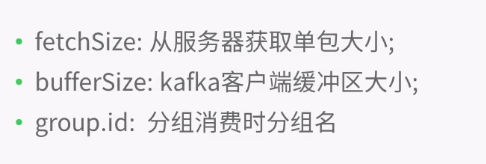
接下来实现生产者,能够像kafka中传递消息
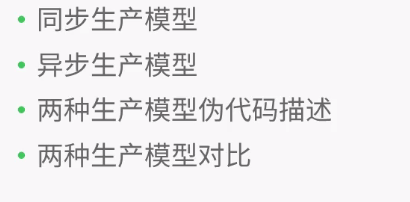
生产者发送消息后会不断确认kafka集群是否收到,如果没收到就会重发,如果达到最大次数就会结束生产
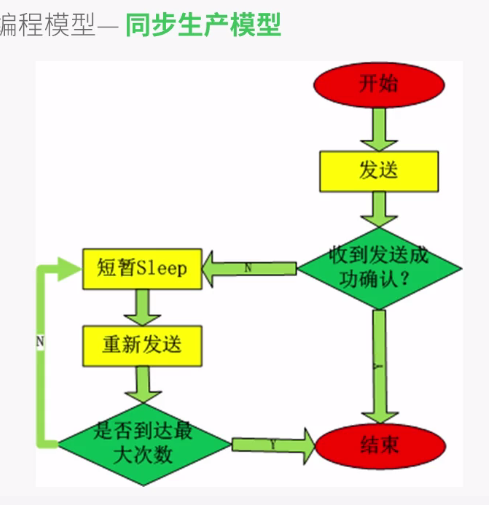
异步生产的时候,消息会事先缓存在客户端,可以设置最大消息缓存数或者累计缓存时间,如果达到设置的标准,就会打包发送给kafka服务器
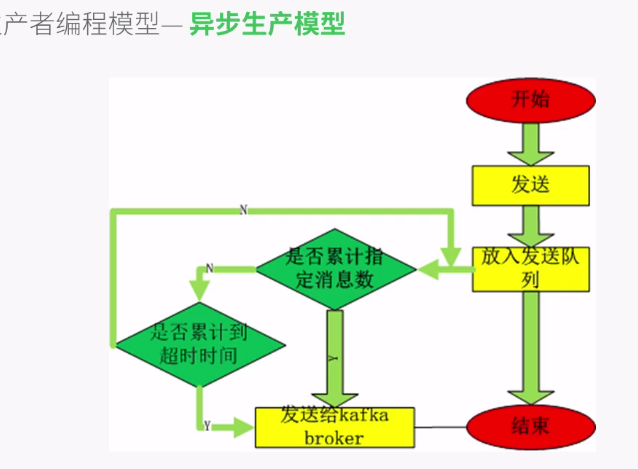
两种模型伪代码描述非常相似,所以用一个就能表示
先创建链接实例,之后配置负载均衡
在设置生产者参数的时候就会定义是同步还是异步
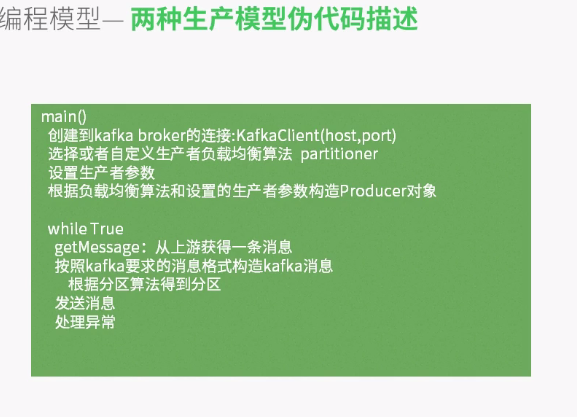
同步模型由于需要同步,所以丢失率基本为0
异步模型中,每个分区每秒可以发送50万条消息
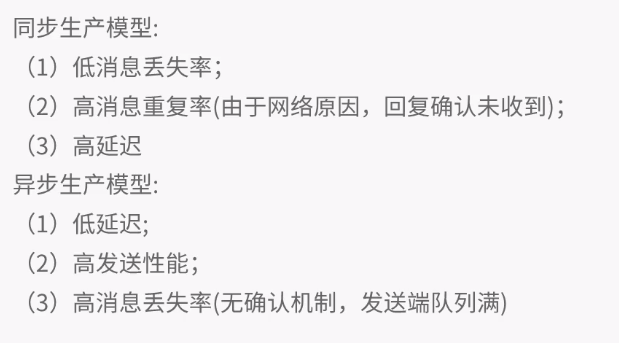
接下来实现Java客户端程序编写:
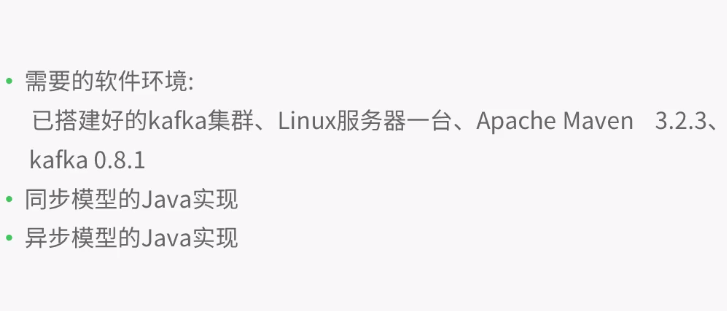
pom文件与上述pom文件一样
同步模型代码如下:
package kafka.producer.sync;
import java.util.*; import kafka.javaapi.producer.Producer;
import kafka.producer.KeyedMessage;
import kafka.producer.ProducerConfig; public class SyncProduce {
public static void main(String[] args) {
long events = Long.MAX_VALUE;
Random rnd = new Random(); Properties props = new Properties();
props.put("metadata.broker.list", "10.206.216.13:19092,10.206.212.14:19092,10.206.209.25:19092");
props.put("serializer.class", "kafka.serializer.StringEncoder");
//kafka.serializer.DefaultEncoder
props.put("partitioner.class", "kafka.producer.partiton.SimplePartitioner");
//kafka.producer.DefaultPartitioner: based on the hash of the key
props.put("request.required.acks", "1");
//0; 绝不等确认 1: leader的一个副本收到这条消息,并发回确认 -1: leader的所有副本都收到这条消息,并发回确认 ProducerConfig config = new ProducerConfig(props); Producer<String, String> producer = new Producer<String, String>(config); for (long nEvents = 0; nEvents < events; nEvents++) {
long runtime = new Date().getTime();
String ip = "192.168.2." + rnd.nextInt(255);
String msg = runtime + ",www.example.com," + ip;
//eventKey必须有(即使自己的分区算法不会用到这个key,也不能设为null或者""),否者自己的分区算法根本得不到调用
KeyedMessage<String, String> data = new KeyedMessage<String, String>("jiketest", ip, msg);
// eventTopic, eventKey, eventBody
producer.send(data);
try {
Thread.sleep(1000);
} catch (InterruptedException ie) {
}
}
producer.close();
}
}
异步模型代码如下:
package kafka.producer.async; import java.util.*; import kafka.javaapi.producer.Producer;
import kafka.producer.KeyedMessage;
import kafka.producer.ProducerConfig; public class ASyncProduce {
public static void main(String[] args) {
long events = Long.MAX_VALUE;
Random rnd = new Random(); Properties props = new Properties();
props.put("metadata.broker.list", "10.206.216.13:19092,10.206.212.14:19092,10.206.209.25:19092");
props.put("serializer.class", "kafka.serializer.StringEncoder");
//kafka.serializer.DefaultEncoder
props.put("partitioner.class", "kafka.producer.partiton.SimplePartitioner");
//kafka.producer.DefaultPartitioner: based on the hash of the key
//props.put("request.required.acks", "1");
props.put("producer.type", "async");
//props.put("producer.type", "1");
// 1: async 2: sync ProducerConfig config = new ProducerConfig(props); Producer<String, String> producer = new Producer<String, String>(config); for (long nEvents = 0; nEvents < events; nEvents++) {
long runtime = new Date().getTime();
String ip = "192.168.2." + rnd.nextInt(255);
String msg = runtime + ",www.example.com," + ip;
KeyedMessage<String, String> data = new KeyedMessage<String, String>("jiketest", ip, msg);
producer.send(data);
try {
Thread.sleep(1000);
} catch (InterruptedException ie) {
}
}
producer.close();
}
}
分区算法:
package kafka.producer.partiton; import kafka.producer.Partitioner;
import kafka.utils.VerifiableProperties; public class SimplePartitioner implements Partitioner {
public SimplePartitioner (VerifiableProperties props) { } public int partition(Object key, int a_numPartitions) {
int partition = 0;
String stringKey = (String) key;
int offset = stringKey.lastIndexOf('.');
if (offset > 0) {
partition = Integer.parseInt( stringKey.substring(offset+1)) % a_numPartitions;
}
return partition;
} }
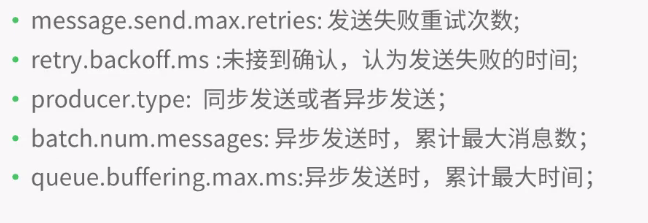
二十二、Hadoop学记笔记————Kafka 基础实战 :消费者和生产者实例的更多相关文章
- 二十一、Hadoop学记笔记————kafka的初识
这些场景的共同点就是数据由上层框架产生,需要由下层框架计算,其中间层就需要有一个消息队列传输系统 Apache flume系统,用于日志收集 Apache storm系统,用于实时数据处理 Spark ...
- 二十、Hadoop学记笔记————Hive On Hbase
Hive架构图: 一般用户接口采用命令行操作, hive与hbase整合之后架构图: 使用场景 场景一:通过insert语句,将文件或者table中的内容加入到hive中,由于hive和hbase已经 ...
- 二十三、Hadoop学记笔记————Spark简介与计算模型
spark优势在于基于内存计算,速度很快,计算的中间结果也缓存在内存,同时spark也支持streaming流运算和sql运算 Mesos是资源管理框架,作为资源管理和任务调度,类似Hadoop中的Y ...
- 二十五、Hadoop学记笔记————Hive复习与深入
Hive主要为了简化MapReduce流程,使非编程人员也能进行数据的梳理,即直接使用sql语句代替MapReduce程序 Hive建表的时候元数据(表明,字段信息等)存于关系型数据库中,数据存于HD ...
- 二十四、Hadoop学记笔记————Spark的架构
master为主节点 一个集群中可能运行多个application,因此也可能会有多个driver DAG Scheduler就是讲RDD Graph拆分成一个个stage 一个Task对应一个Spa ...
- 十九、Hadoop学记笔记————Hbase和MapReduce
概要: hadoop和hbase导入环境变量: 要运行Hbase中自带的MapReduce程序,需要运行如下指令,可在官网中找到: 如果遇到如下问题,则说明Hadoop的MapReduce没有权限访问 ...
- 十八、Hadoop学记笔记————Hbase架构
Hbase结构图: Client,Zookeeper,Hmaster和HRegionServer相互交互协调,各个组件作用如下: 这几个组件在实际使用过程中操作如下所示: Region定位,先读取zo ...
- 十七、Hadoop学记笔记————Hbase入门
简而言之,Hbase就是一个建立在Hdfs文件系统上的数据库(mysql,orecle等),不同的是Hbase是针对列的数据库 Hbase和普通的关系型数据库区别如下: Hbase有一些基本的术语,主 ...
- python3.4学习笔记(二十六) Python 输出json到文件,让json.dumps输出中文 实例代码
python3.4学习笔记(二十六) Python 输出json到文件,让json.dumps输出中文 实例代码 python的json.dumps方法默认会输出成这种格式"\u535a\u ...
随机推荐
- 排序算法(二)Sort with Swap(0,*)
对于一个由0到N-1的序列,如果只能交换0和另一个数的位置,求多少次能够将序列变为递增序列. 输入为<N> <序列>(N和序列之间有一个空格,序列元素之间均有一个空格). 设序 ...
- 写论文如何做相关工作(realted work)的调研
1.找一篇目标研究领域的中文综述,读懂,对该领域有了些基本的了解,如何找到好的综述,就是要关注一些大牛的实验组的综述和进展: 2.找该中文综述引用的外文文献来看,通常是一些比较经典的文献 3.找这些外 ...
- Android百分比布局支持库(android-percent-support)
Android中提供了五种布局,其中用的最多的就是:LinearLayout, RelativeLayout 和 FrameLayout这三种布局,在对某一界面进行布局时最先想到也是通过这三种来布局的 ...
- UnityEditor下文件操作方法汇总(Unity3D开发之二十四)
猴子原创,欢迎转载.转载请注明: 转载自Cocos2Der-CSDN,谢谢! 原文地址: http://blog.csdn.net/cocos2der/article/details/50595585 ...
- OpenCV——PS 滤镜, 浮雕效果
具体的算法原理可以参考: PS 滤镜, 浮雕效果 // define head function #ifndef PS_ALGORITHM_H_INCLUDED #define PS_ALGORITH ...
- Hbase 备份的方式
HBase 备份的方式有三种: 1.下线备份 (1)停止集群. (2)Distcp (3)restore 2.在线备份 -replication 3.在线北大 -CopyTable 4.在线备份-Ex ...
- 记——加快gradle 构建速度的经验
Gradle作为一个新的构建系统,无疑在灵活,扩展,跨平台等各方面都表现得非常优秀,然而,它也有一点备受吐槽,就是速度慢.以下为本人使用gradle过程中,几次加快gradle构建速度的经验之谈. 本 ...
- IOS中UITextView(多行文本框)控件的简单用法
1.创建并初始化 UITextView文本视图相比与UITextField直观的区别就是UITextView可以输入多行文字并且可以滚动显示浏览全文.UITextField的用处多,UITextVie ...
- javascript函数式编程一例分析
js像其他动态语言一样是可以写高阶函数的,所谓高阶函数是可以操作函数的函数.因为在js中函数是一个彻彻底底的对象,属于第一类公民,这提供了函数式编程的先决条件. 下面给出一个例子代码,出自一本js教程 ...
- 03_Linux FTP
linux搭建ftp server,在windows向上传 http://www.2cto.com/os/201204/126898.html yum install vsftp.rpm 安装v ...
